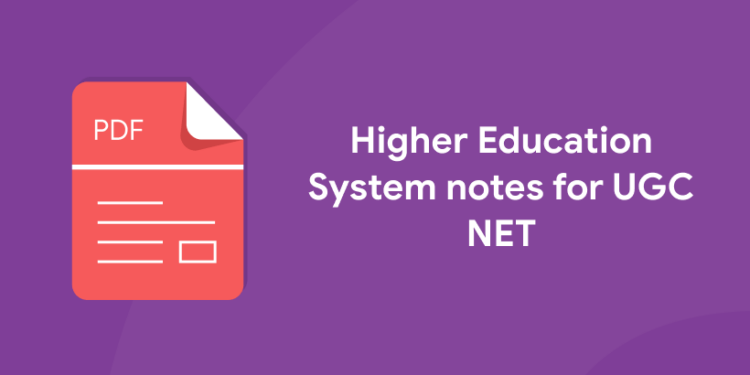Table of Contents
UGC NET (National Eligibility Test) is stated to be a national level exam which is conducted by NTA (National Testing Agency) on behalf of the University Grants Commission (UGC). It is for authorizing the eligibility of aspirants for the respective posts of ‘Assistant Professor’ or ‘Junior Research Fellowship’.
The UGC NET 2022 online registrations and application shall start in March 2022 on the official website after the release of the official announcement.
UGC NET Paper–I, is the first stage to qualify for the National Eligibility Test. The Higher Education System is one of the essential topics from UGC NET Paper 1. To enhance the score in UGC NET 2021 Exam, you should have deep learning about all the essential topics of UGC NET Paper I.
To extend your exam preparation for Paper 1, we have furnished the latest UGC NET Higher Education System Notes.
For More Information on UGC NET Exam, Download Entri App Now!
UGC NET Exam Higher Education System Syllabus
Topics that are completed as per the syllabus for UGC NET Exam Paper 1 :
- Ancient Indian Higher learning institutions and education
- Post-Independence Indian Higher learning evolution and research.
- Professional, Technical and Skill-Based education
- Value education and environmental education
- Policies, Governance, and Administration
Higher Education System Notes UGC NET
Ancient Indian Higher learning institutions and education
The history of education in ancient India is captivating and is documented and can be traced to the ancient era. Education in ancient India started around the 3rd century B.C with aspects of religious activity and impart of traditional knowledge. Sages and scholars presented education orally. Palm leaves and barks of trees were utilized for writing.
In ancient India, both formal and informal forms of education systems existed. Indigenous education was functioned at home, in temples, pathshalas, and gurukuls and there were people in homes, villages, and temples who trained young children in imbibing pious states of life. Temples were also the centers of learning and took a claim in the promotion of knowledge of our ancient system. Students went to viharas and universities for higher learning in ancient India.
Download the Entri Learning App for More Notes On UGC NET Exam
Post-Independence Indian Higher learning evolution and research.
India has always been recognized as a knowledge corner since the origin of human civilization. Indian higher education system has been noticing metamorphic transformations and challenges through the years, i.e., from the ancient Gurukul system to the modern technology-based learning system have altered the lives of millions of people.
- This is clear from bases of learning which existed in the 7th century BC were the Buddhist monasteries and in the 3rd century AD was Nalanda. Few of these bases were very large having several faculties. Invasions and disorder in the country have destroyed the ancient Indian education system.
- The first college was set up in 1918 in Serampore in Bengal completing western education in India. In 1857, three Central Universities of Calcutta, Bombay, and Madras were established, 27 colleges were affiliated. There were 19 Universities in 1947 in India.
- The Higher education system in India has evolved remarkably after the post-independence period and evolved into the largest Higher Education System in the world.
- The Indian higher education system has invented its system and design. Since the Indian constitutions nourish for joint responsibility of the union and state government for the advancement of education.
- The connection between learning, research, and invention within higher education is the key to the construction of sustainable knowledge societies.
- Based on the requirements for academic, administrative, and financial flexibility, there are distinct kinds of universities and institutions in the higher education system in the country
- India has various Higher education institutions namely, central and state universities, unitary and affiliating universities, institutions of national importance, considered to be universities, and open universities.
- The central government via the University Grants Commission (UGC) or the AICTE supplies support to different state-run universities. Universities in India functionally are multi-faculty universities, single faculty universities (agricultural, technological, and medical universities) apart from the universities there are also institutions of national significance like IITs, IIMs considered to be universities (BITS, IISc).
- The higher education system in the country is controlled by considerable agencies with University Grant Commission (UGC) as the apex body.
- The laws and regulations by these agencies create the higher education system more complex. The different stakeholders in the regulatory framework in the country are state governments, professional councils like University Grant Commission (UGC), the All India Council for Technical Education (AICTE), etc.
The effect of Higher education in India after post-independence is remarkable. It is more than half a century ever since the government started a designed expansion of higher education in the country especially with the establishment of the University Grants Commission in 1953.
Professional, Technical and Skill-Based education
Skill development is the key element in every individual’s life if they want to be employed. Every country requires individuals with a higher level of talent and educational stuff. We can’t say that people with good educational credentials will certainly get a career or skilled person will get a job. An individual who wants to get employed will have to maintain both the things together i.e., right education and a higher level of skills.
Value education and environmental education
According to C. V. Good —” Value-education is the aggregate of all the process employing which a person develops abilities, attitudes and other forms of behavior of the positive values in the society in which he lives.”
The National Policy on Education has applied considerable emphasis on Value Education by emphasizing the necessity to make education a proactive tool for the cultivation of social and moral values. The policy has declared that in our culturally plural society education should factor universal and eternal values instructed towards the unity and integration of our people.
Environmental Education
Environmental education allows learners to devise a structure of knowledge about the world and pursue knowledge that they can use and evolve throughout their lives. Environmental education delegates learners by allowing them to participate in a sustainable future. Thus, the foundation for lifelong education is applied by environmental education.
Policies, Governance, and Administration
Most of the questions were asked from Topics established on Higher Education, yet, questions were also asked based on Policies, Governance, and Administration. To Cover the complete Policies, Governance Model, and administration is beyond the content of this article, and also this is an Extensive topic for those who are preparing for the exam. Most of the time 2-3 Questions were asked based on the below topics. Main Topics:
- Introduction of Indian constitution & Articles in Our Constitution
- Fundamental rights and duties Key points of various administration post
- Details of President Roles & Responsibility
- Details of Vice-President Roles & Responsibility
- Details of Prime-minister
- Apex bodies of Governance like election commission and state governing bodies.
- Important Policy & Schemes of Govt of India
By the end of this article, you will have a good understanding of the Higher Education System in India. Utilize the notes for the better study preparation of UGC NET General Paper 1 Higher Education System. The Entri Learning App also provides the entire study notes on UGC NET Paper.













